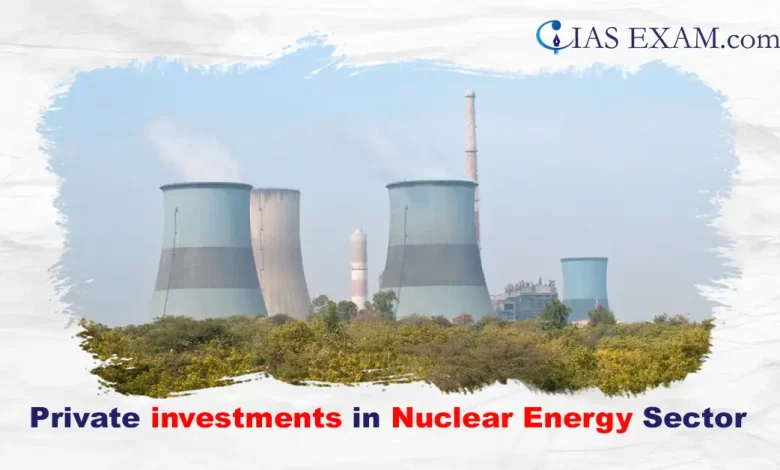Daily Current Affairs for UPSC
Private investments in Nuclear Energy Sector
Syllabus- Science & generation [GS Paper-3]

Context – India is planning to invite private investments of approximately $26 billion in its nuclear energy sector.
About
- The government plans to build 11,000 megawatts (MW) of new nuclear energy generation capability by 2040.
- Under the investment plan, the private companies will make the investments in the nuclear plant, acquire land, water and adopt construction in areas outside the reactor complex of the plant.
- However, the rights to construct and run the stations and their fuel management will rest with the Nuclear Power Corporation of India (NPCIL).
- The plan will now not require any change to India’s Atomic Energy Act of 1962 but will need a final cross-ahead from the Department of Atomic Energy.
- Indian law bars private companies from setting up nuclear energy plants, however, allows them to supply additives, equipment and sign construction contracts for work outside of the reactors.
Benefits of Private Investment
- Achieve the energy goal: The proposed funding is essential for India to achieve its goal of getting 50% of its established electric generation potential sourced from non-fossil fuels by 2030, as compared to the present day 42%.
- Increased Efficiency: Private companies convey more efficient management practices, technological improvements, and innovation to the sector.
- Innovation and Research: Private investment incentivizes the improvement of advanced reactor designs, fuel cycles, protection structures, and waste management answers, leading to long-term sustainability and competitiveness within the region.
- Financial Resources: Private funding presents additional economic sources for the development and growth of nuclear infrastructure.
What is Nuclear Energy?
- Nuclear power is the power released during nuclear reactions, either through fission (splitting of atomic nuclei) or fusion (merging of atomic nuclei).
- In nuclear fission, heavy atomic nuclei, along with the ones of uranium or plutonium, are split into lighter nuclei, releasing a large amount of energy.
- This process is applied in nuclear power plants to generate power.
India’s Nuclear Programme
- Nuclear Energy is a non-carbon-emitting power source that contributes less than 2% of India’s overall energy generation.
- NPCIL owns and operates India’s cutting-edge fleet of nuclear power plant, with a capability of 7,500 MW, and has devoted investments for another 1,300 MW.
- India imports uranium fuel for nuclear plants from Russia, Kazakhstan, Uzbekistan, France and Canada under bilateral agreements.
Advantages of Nuclear Energy
- Energy Security: Nuclear energy with its high energy output can remedy the energy disaster that the arena is dealing with today. The fuel to electricity output ratio for nuclear power is tremendously high. An exceedingly small quantity of uranium can be used to fuel a 1000 Megawatts electric powered plant, for that reason offering enough electricity to power a city of about half of a million human beings.
- Clean electricity: Nuclear power plants have a low efficient house fuel footprint. The World Nuclear Association determined that the common emissions for nuclear electricity are 29 tonnes of CO2 per gigawatt-hour (GWh) of electricity produced.
- This compares favorably with solar (85 tonnes consistent with GWh), wind (26 tonnes consistent with GWh) and fossil fuels like lignite (1,054 tonnes according to GWh).
- Low Operating Costs: Nuclear energy produces very less expensive energy and is inexpensive than fuel, coal, or some other fossil fuel plant.
Disadvantages of Nuclear Energy
- Risky source of energy: The dangers of nuclear electricity are in the long run uncontrollable. The Chernobyl catastrophe of 1986 and Fukushima disaster in Japan in 2011 have already proven the risks of nuclear power.
- Not truly renewable: Uranium, the nuclear fuel that is used to supply nuclear power, is restrained and cannot be produced time and again on call for.
- Radioactive Waste Disposal: A nuclear energy plant creates 20 metric tons of nuclear fuel in keeping with yr, and with that comes loads of nuclear waste. The more a part of this waste transmits radiation and high temperature, inflicting damage to living things in and across the plant.
Source: The Hindu
UPSC Mains Practice Questions:
Q.In order to meet growing energy demands, nuclear power is one of the better solutions. Critically discuss. (250 Words)





.png)



